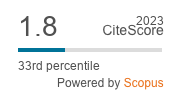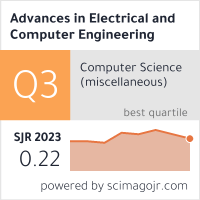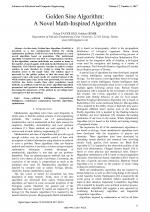| 2/2017 - 10 |
Golden Sine Algorithm: A Novel Math-Inspired AlgorithmTANYILDIZI, E. |
| View the paper record and citations in |
| Click to see author's profile in |
| Download PDF |
Author keywords
artificial intelligence, computational intelligence, evolutionary computation, heuristic algorithms, optimization
References keywords
optimization(24), algorithm(14), algorithms(7), inspired(5), computation(5), yang(4), swarm(4), software(4), jadvengsoft(4), evolutionary(4)
Blue keywords are present in both the references section and the paper title.
About this article
Date of Publication: 2017-05-31
Volume 17, Issue 2, Year 2017, On page(s): 71 - 78
ISSN: 1582-7445, e-ISSN: 1844-7600
Digital Object Identifier: 10.4316/AECE.2017.02010
Web of Science Accession Number: 000405378100010
SCOPUS ID: 85020089767
Abstract
In this study, Golden Sine Algorithm (Gold-SA) is presented as a new metaheuristic method for solving optimization problems. Gold-SA has been developed as a new search algorithm based on population. This math-based algorithm is inspired by sine that is a trigonometric function. In the algorithm, random individuals are created as many as the number of search agents with uniform distribution for each dimension. The Gold-SA operator searches to achieve a better solution in each iteration by trying to bring the current situation closer to the target value. The solution space is narrowed by the golden section so that the areas that are supposed to give only good results are scanned instead of the whole solution space scan. In the tests performed, it is seen that Gold-SA has better results than other population based methods. In addition, Gold-SA has fewer algorithm-dependent parameters and operators than other metaheuristic methods, increasing the importance of this method by providing faster convergence of this new method. |
| References | | | Cited By «-- Click to see who has cited this paper |
| [1] S. Mirjalili, S. M. Mirjalili, A. Lewis, "Grey wolf optimizer", Advances in Engineering Software, vol. 69, pp. 46-61, 2014. [CrossRef] [Web of Science Times Cited 10718] [SCOPUS Times Cited 13833] [2] G. Demir, B. Alatas, "Lig sampiyonasi algoritmasi ile gezgin satici probleminin çözümü", 1st International Conference on Engineering Technology and Applied Sciences (ICETAS), Afyon, Turkey, pp. 793-800, 2016. [3] A. Prakasam, N. Savarimuthu, "Metaheuristic algorithms and polynomial turing reductions: a case study based on ant colony optimization", Procedia Computer Science, vol. 46, pp. 388-395, 2015. [CrossRef] [Web of Science Times Cited 9] [SCOPUS Times Cited 7] [4] I. Fister Jr., X. S. Yang, D. Fister, I. Fister, "A brief review of nature-inspired algorithms for optimization", Elektrotehniski Vestnik, vol. 80, no. 3, pp. 1-7, 2013. [5] J. H. Holland, "Genetic algorithms", Scientific American, vol. 267, pp. 66-72, 1992. [CrossRef] [Web of Science Times Cited 2616] [SCOPUS Times Cited 4449] [6] D. Simon, "Biogeography-based optimization", Evolutionary Computation, IEEE Transactions on, vol. 12, no. 6, pp. 702-713, 2008. [CrossRef] [Web of Science Times Cited 2996] [SCOPUS Times Cited 3648] [7] Y. Shi, "An optimization algorithm based on brainstorming process", International Journal of Swarm Intelligence Research (IJSIR), vol. 2, no.4, pp. 35-62, 2011. [CrossRef] [Web of Science Times Cited 160] [8] A. Kaveh and N. Farhoudi, "A new optimization method: Dolphin echolocation", Advances in Engineering Software, vol. 59, pp. 53-70, 2013. [CrossRef] [Web of Science Times Cited 357] [SCOPUS Times Cited 455] [9] X. S. Yang, "Flower pollination algorithm for global optimization", Unconventional Computation and Natural Computation, pp. 240-249, 2012. [CrossRef] [SCOPUS Times Cited 1972] [10] J. Kennedy, R. Eberhart, "Particle swarm optimization", in Neural Networks, Proceedings, IEEE International Conference on, vol. 4, pp. 19421948, IEEE, 1995. [CrossRef] [Web of Science Times Cited 32665] [11] M. Dorigo, "Optimization, learning and natural algorithms", Ph. D. Thesis, Politecnico di Milano, Italy, 1992. [12] K. M. Passino, "Biomimicry of bacterial foraging for distributed optimization and control", Control Systems, IEEE, vol. 22, no. 3, pp. 52-67, 2002. [CrossRef] [Web of Science Times Cited 1987] [SCOPUS Times Cited 2747] [13] X. S. Yang, "A new metaheuristic bat-inspired algorithm", Nature Inspired Cooperative Strategies for Optimization (NICSO 2010), vol. 284, pp. 65-74, 2010. [CrossRef] [Web of Science Times Cited 3153] [SCOPUS Times Cited 4489] [14] X. S. Yang, "Firefly algorithm, stochastic test functions and design optimization", International Journal of Bio-Inspired Computation, vol. 2, no. 2, pp. 78-84, 2010. [CrossRef] [Web of Science Times Cited 559] [SCOPUS Times Cited 2202] [15] S. Mirjalili, "The ant lion optimizer", Advances Engineering Software, vol. 83, pp. 80-8, 2015. [CrossRef] [Web of Science Times Cited 2192] [SCOPUS Times Cited 2738] [16] S. Mirjalili, S. M. Mirjalili, "The whale optimization algorithm", Advances Engineering Software, vol. 95, pp. 51-67, 2016. [CrossRef] [Web of Science Times Cited 7774] [SCOPUS Times Cited 9879] [17] A. Hatamlou, "Black hole: A new heuristic optimization approach for data clustering", Information Sciences, vol. 222, pp. 175-184, 2013. [CrossRef] [Web of Science Times Cited 913] [SCOPUS Times Cited 1099] [18] A. Kaveh, S. Talatahari, "A novel heuristic optimization method: charged system search", Acta Mechanica, vol. 213, no. 3, pp. 267-289, 2010. [CrossRef] [Web of Science Times Cited 948] [SCOPUS Times Cited 1123] [19] E. Cuevas, D. Oliva, D. Zaldivar, M. Perez, R. Rojas, "Circle detection algorithm based on electromagnetism-like optimization", vol. 38, pp. 907-934, 2013. [CrossRef] [SCOPUS Times Cited 4] [20] E. Rashedi, H. N. Pour, S. Saryazdi, "GSA: a gravitational search algorithm. Information sciences", vol. 179, no. 13, pp. 2232-2248, 2009. [CrossRef] [Web of Science Times Cited 4950] [SCOPUS Times Cited 6060] [21] Z. W. Geem, J. H. Kim, G. V. Loganathan, "A new heuristic optimization algorithm: harmony search", Simulation, vol. 76, no. 2, pp. 60-68, 2001. [22] H. Shayeghi, J. Dadashpour, "Anarchic society optimization based pid control of an automatic voltage regulator (avr) system", Electrical and Electronic Engineering, vol. 2, no. 4, pp. 199-207, 2012. [CrossRef] [23] E. A. Gargari, C. Lucas, "Imperialist competitive algorithm: an algorithm for optimization inspired by imperialistic competition", Evolutionary Computation, 2007, CEC 2007, IEEE Congress on, pp. 4661-4667, IEEE, 2007. [CrossRef] [Web of Science Times Cited 1897] [SCOPUS Times Cited 2374] [24] F. Ramezani, S. Lotfi, "Social-based algorithm", Applied Soft Computing, vol. 13, pp. 2837-2856, 2013. [CrossRef] [Web of Science Times Cited 112] [SCOPUS Times Cited 126] [25] S. A. Salem, "BOA: A novel optimization algorithm", International Conference on Engineering and Technology (ICET), pp. 1-5, Egypt, IEEE, 2012. [CrossRef] [SCOPUS Times Cited 32] [26] S. Mirjalili, "SCA: A Sine Cosine Algorithm for solving optimization problems", Knowledge-Based Systems, vol. 96, pp. 120-133, 2016. [CrossRef] [Web of Science Times Cited 3336] [SCOPUS Times Cited 4072] [27] F. Altunbey, B. Alatas, "Sosyal ag analizi için sosyal tabanli yapay zeka optimizasyon algoritmalarinin incelenmesi", Int. J. Pure Appl. Sci., vol. 1, pp. 33-52, 2015. [28] R. K. Arora. Optimization Algorithms and Applications. ISBN-13: 978-1-4987-2115-8. pp. 46-47, 2015. [29] P. N. Suganthan, N. Hansen, J. J. Liang, K. Deb, Y. Chen, A. Auger, "Problem definitions and evaluation criteria for the CEC 2005 special session on realparameter optimization" KanGAL report, vol. 2005005, 2005. [30] J. Derrac, S. García, D. Molina, F. Herrera, "A practical tutorial on the use of non-parametric statistical tests as a methodology for comparing evolutionary and swarm intelligence algorithms", Swarm Evol. Comput., vol.1, no.1, pp. 3-18, 2011. [CrossRef] [Web of Science Times Cited 3967] [SCOPUS Times Cited 4344] [31] C. A. C. Coello, "Theoretical and numerical constraint-handling techniques used with evolutionary algorithms: a survey of the state of the art". Comput Methods Appl Mech Eng, vol. 191, no.11-12, pp. 1245-1287, 2002. [CrossRef] [Web of Science Times Cited 1638] [SCOPUS Times Cited 1913] [32] S. H. Nasseri, Z. Alizadeh, F. Taleshian, "Optimized solution of pressure vessel design using geometric programming", The Journal of Mathematics and Computer Science, vol. 4, no. 3, pp. 344 349, 2012. [33] M. Li, H. Zhao, X. Weng, T. Han, "Cognitive behavior optimization algorithm for solving optimization problems", Applied Soft Computing, vol. 39, pp. 199 222, 2016. Web of Science® Citations for all references: 82,947 TCR SCOPUS® Citations for all references: 67,566 TCR Web of Science® Average Citations per reference: 2,440 ACR SCOPUS® Average Citations per reference: 1,987 ACR TCR = Total Citations for References / ACR = Average Citations per Reference We introduced in 2010 - for the first time in scientific publishing, the term "References Weight", as a quantitative indication of the quality ... Read more Citations for references updated on 2024-10-21 15:03 in 164 seconds. Note1: Web of Science® is a registered trademark of Clarivate Analytics. Note2: SCOPUS® is a registered trademark of Elsevier B.V. Disclaimer: All queries to the respective databases were made by using the DOI record of every reference (where available). Due to technical problems beyond our control, the information is not always accurate. Please use the CrossRef link to visit the respective publisher site. |
Faculty of Electrical Engineering and Computer Science
Stefan cel Mare University of Suceava, Romania
All rights reserved: Advances in Electrical and Computer Engineering is a registered trademark of the Stefan cel Mare University of Suceava. No part of this publication may be reproduced, stored in a retrieval system, photocopied, recorded or archived, without the written permission from the Editor. When authors submit their papers for publication, they agree that the copyright for their article be transferred to the Faculty of Electrical Engineering and Computer Science, Stefan cel Mare University of Suceava, Romania, if and only if the articles are accepted for publication. The copyright covers the exclusive rights to reproduce and distribute the article, including reprints and translations.
Permission for other use: The copyright owner's consent does not extend to copying for general distribution, for promotion, for creating new works, or for resale. Specific written permission must be obtained from the Editor for such copying. Direct linking to files hosted on this website is strictly prohibited.
Disclaimer: Whilst every effort is made by the publishers and editorial board to see that no inaccurate or misleading data, opinions or statements appear in this journal, they wish to make it clear that all information and opinions formulated in the articles, as well as linguistic accuracy, are the sole responsibility of the author.





